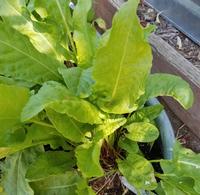Sorrel
Three popular varieties of sorrel are garden sorrel (Rumex acetosa), French sorrel (R. scutatus), and red veined sorrel (R. sanguineus). French sorrel is the preferred variety for culinary use. It grows throughout Europe, in almost all soils and situations. The arrow shaped leaves have a bright, lemony flavor, and are good additions to soups, stews, sandwiches, and salads. Cooking greatly reduces the tartness. Red veined sorrel is typically more bitter than French sorrel, and is often grown as an ornamental.
How to grow
Sorrel is cold-hardy and grows vigorously in spring.
- Type: Perennial, tender leafed
- Light: Full sun; can tolerate some shade
- Soil: Well drained
- Water: Drought tolerant once established
- Size: Generally 1–3 feet tall, depending on variety. 6 inches wide to start, but will spread continuously
When to plant/propagate
- From seed: Sow seeds in early spring. Or start seed indoors 3 weeks before last frost date
- Transplants: Plant transplants in spring after last frost
- Cuttings & divisions: Propagate via root division in spring or fall
Harvesting
- Harvest the young, tender leaves for uncooked dishes. Keep refrigerated for up to two weeks, or preserve by freezing
- Sorrel contains a significant amount of oxalic acid, which may be a problem for people with certain health conditions
Indoors: Sorrel can be grown as an indoor plant with 6 hours of bright light from a sunny window, or 12–16 hours of supplemental light provided by cool white fluorescent or LED lamps
Common pests & diseases
More information
- Growing Sorrel in Home Gardens, University of Minnesota Extension
- Grow Herbs!, UCCE Master Gardeners of Sacramento County
- Try drought-tolerant sorrel in your edible landscape, UCCE Master Gardeners of Marin County







